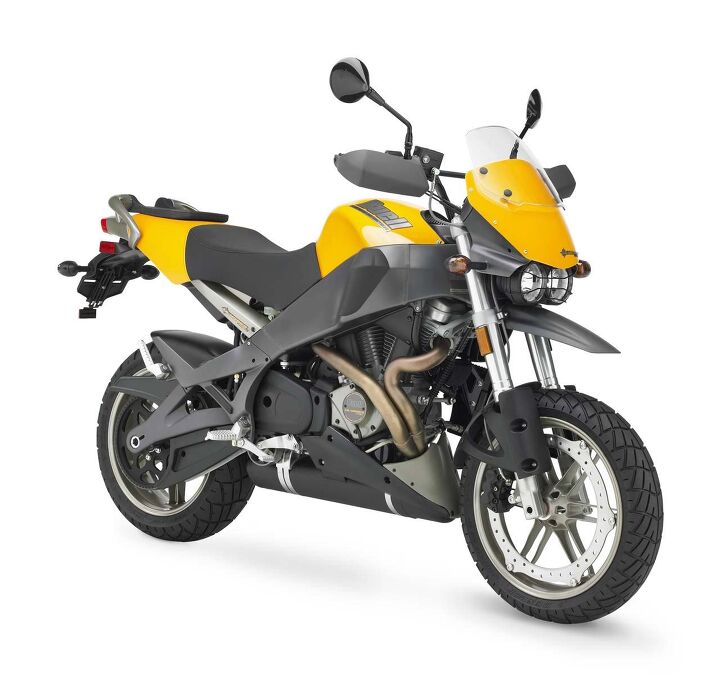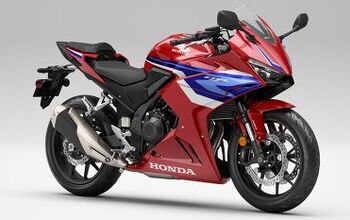Top 10 Cult Bikes of the Modern Era
Extraordinary motorcycles for out-of-the-ordinary riders
Cult: A small religious group that is not part of a larger and more accepted religion and that has beliefs regarded by many people as extreme or dangerous; a situation in which people admire and care about something or someone very much or too much. —Merriam-Webster
What is a cult bike anyway? Our working definition wound up being a bike that was relatively easily attainable by the average motorcyclist within the last 20 or 30 years – so no NR750s or Brittens. A cult bike has to be slightly oddball: Honda VFRs and BMW GSs are popular enough that their adherents constitute more a religion than a cult. It’s tough to separate cult bikes from collectibles, too. A cult bike is one most people looked right past when it was new, which is why a Honda RC30, a Bimota DB4, and a Z1 Kawasaki can’t be one. Who wouldn’t want one of those? Nay, cult bikes are what emerge from misty nights on the moor when you’re far from home with a flat tire. (What’s a moor anyway?) A wolf howls, a cloud scuds past a waning moon, and just then you see a single headlight coming your way, possibly dim and flickering. A bearded guy in goggles pulls up on a…
10. 1987-current Kawasaki KLR650
This one actually started out 30 years ago, if you believe Wikipedia, and there it still is as a 2017 model on Kawasaki.com, starting at $6,699. Please let me know if there are any other motorcycles that have had one major redesign (2008) in 30 years and are still being sold. (Ha! There is one more later in the list!) The holiest holy within the KLR cult might be the rare Tengai, a slightly streetier version with more Paris-Dakar styling which only came to the USA in 1990, and not in this red color scheme. Anyway, serious adventurers and world travelers love their indestructible KLRs, so do die-hard dual-sporters, soldiers, commuters, Jamie Elvidge, and other discriminating appreciators of fine, trustworthy saddle horses.
9. 1988-91 Honda NT650 Hawk
For sure-a, the Hawk was a great little scoot, and Danny Coe’s favored tool for carving up Latigo Canyon when I first came to work in the magazine biz a few years ago. Who could deny the exotic single-sided swingarm, Cobas-style beam frame and decades-ahead exhaust system? Today the Hawk’s following, though, seems to be way out of proportion to the little 647cc Twin’s performance, which was roughly equivalent to a current Guzzi V7 Sport. That didn’t stop Kevin Erion of what was then Two Brothers Racing from winning a championship or two on a really potent version, and it doesn’t stop plenty of people from loving and racing their Hawks to this day.
8. 1998-2000 Cagiva Gran Canyon
What’s not to like? An air-cooled 904cc Ducati V-Twin from the 900SS hijacked into the steel frame of the Paris-Dakar-winning and dearly departed Cagiva Elefant – a bike that pretty much predicted the current ADV boom at a time when most of us were constantly addled by the jiggling flesh of an out-of-control high-power sportbike orgy. Cooler heads appreciated the Gran Canyon then and current ones who poopoo electronics and social media still love their Pierre Terblanche-designed Gran Canyons.
7. 2006-09 Buell Ulysses
Another important part of being in a cult is having a large part of the rest of the population think you’re out of your mind; having a little taste for persecution and a thick streak of independence serves the cultist well. There aren’t many brands that separate motorcyclists into opposing camps as quickly as Buell. I have to admit I’ve never ridden a Ulysses, but it’s just an ADV version of the XB9/12S, which is one of the greatest motos of all time. Peter Egan still hasn’t sold his Ulysses, highly unusual behavior for the world’s most beloved motojournalist, since one of PE’s major motifs is buying, selling, and re-buying vehicles. Possibly the ultimate praise for the Ulysses.
6. 2008-15 KTM RC8
This one could be a little subjective, but when I had one of these for a couple weeks during the time they were circulating in KTM’s press fleet, I was hugely impressed by the booming V-Twin beast. Also its futuristic style, adjustable ergos that were really adjustable, and overall rambunctious puppy demeanor – it reminded me of a really advanced Honda Superhawk. Why aren’t people buying these, I wondered? Well, in the hair-splitting world of Superbike Shootouts, the RC didn’t win any, and oh yeah, it also had the bad luck to debut in 2008. Hellooo, economic freefall… It’s definitely a bike you don’t see every day.
2010 Literbike Shootout: Aprilia RSV4 Factory Vs. Ducati 1198S Vs. KTM RC8R
5. 1999-current Suzuki Hayabusa
One of the greatest new-model launches of all time. Not only did I nearly get a knee down on the Spanish freeway, so rapido was the copper falcon at top whack. I also got to spend half a day (maybe it was a whole one?) blasting the thing around Circuit Catalunya: One of my most cherished memories is sneaking up behind famed journalist John Ulrich in Turn 10, and giving him a gentle tootle of the horn. The Hayabusa has a distinct cult, as its cult is also a sizable chunk of a race: The African-American community seems to have embraced the Hayabusa like no other sportbike. Impeccable taste! The ’Busa is so good that Suzuki’s still stamping them out. Hai!
4. 1985-current Yamaha VMax
I know I said 30 years, but we’re making an exception for the VMax, which turns 32 this year. Happy Birthday, old fella. Nobody knew they needed a musclebound V-Four hellhound naked bike at the time, but Yamaha must’ve had more Venture Royale engines than they needed, so what the hell. The VMax rocketed to the top of the charts in the go-go ’80s, then sort of faded. Though it never faded away entirely of course, since Yamaha still sells brand new ones. I’ll never forget the maniac I met on the Iron Butt in the early ’90s, who’d occasionally rocket past my Gold Wing on his loud-piped VMax with Woody Woodpecker graphics.
The one major redesign happened for the 2009 model year. As for me, I still see quite a few Gen-1 bikes, and almost no newer ones. With that V-Four now grown to a full 102 cubic inches (1679 cc), there’s still nothing quite like a blast on a VMax to unclog your pipes.
3. 1988-90 Honda Pacific Coast
Honda’s desire to recruit car drivers is not a new thing. What better enticement than a bike with a big trunk and all its mechanicals tucked out of sight? There was no automatic transmission available; aside from that omission, you could really think of this thing as the world’s biggest, fastest scooter. Being an ’80s Honda, of course, the PC was eminently efficient as well as fun to ride. Haters were many, loyalists were few but rabid. Unsurprisingly, all five on Cycle Trader look clean and well-loved, including the 134,000-mile one in Nebraska with the factory stereo.
2. A TIE!! 1986 Yamaha SRX-600 and 1990-91 Honda GB500
According to everybody who was there, dealers couldn’t give either of these away when they were new. Both were, of course, Japanese homages to the great British Singles of yore and both were functionally much better motorcycles than their inspirations. But in that time frame, the Japanese sportbike war was just heating up. For the price of an SRX you could have a four-cylinder FZ600 covered in racy plastic bodywork! Take this test: On the Cycle World official command key rack, the GB key is hanging next to the new CBR600F2. Which one will you have for the weekend? As a result, not many of either of these bikes were sold in the U.S. Not surprisingly, it’s now easier to find a clean SRX or GB than an original clean FZ600 or CBR-F2. How’s that work?
1. 1982 Harley-Davidson FXR
You knew the number one cult bike had to be a Harley, the question was which one? Street Glides and Sportsters both have enough adherents to qualify as full-blown religions. The FXR, though, might be the holy of holies, the bike that brought Harley back from the dead after AMF and the Japanese juggernaut had crucified it in the ’70s. That which did not kill H-D really did make it stronger, though, and management even saw fit to heed the advice of a young engineer and AMA racer, Erik Buell, who took up the challenge of honing the FL touring-based model into a motorcycle that could actually be ridden by enthusiasts. Once the stone was rolled away, the FXR emerged lighter, stiffer and way more fun to ride than any previous Big Twin. The rest, as they say, is history.
More by John Burns






































Comments
Join the conversation
Ummmm?
Air cooled (2010-12) Ducati Hypermotard 1100's
C'mon guys
I cannot believe you left off the Triumph Bonnieville off the list! If ever there was a cult bike, its the Bonnieville.